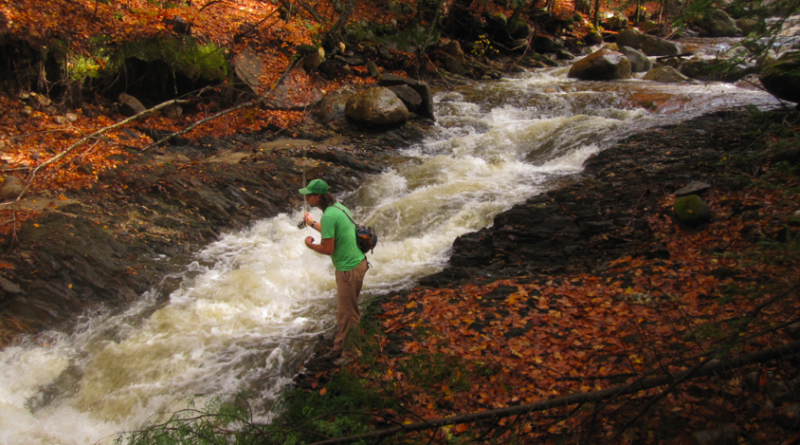In the Dog Days of Summer, Here’s Where to Fish
As water levels fall and temperatures rise on streams throughout New England, fly anglers are confronted with a choice: break out the heavy gear and start throwing streamers for monster pike and bass, or head for the hills in search of small stream brook trout.
By Weyland Joyner
Summer Heat
Trout streams become unfishable for catch-and-release anglers once water temperatures hit 70 degrees. At this point, dissolved oxygen in the water falls to a level where a hooked trout will build up excess lactic acids during the fight. More often than not, this fish, once released, is too exhausted to survive.
This doesn’t necessarily mean that fishermen should take up golf, it simply means that we must be especially responsible as summer heats up. A thermometer is probably the single most important piece of gear to have when venturing onto trout streams in the summer.
In the early mornings lower portions of rivers may be in the mid-60s, temperature-wise, but as the day wears on and the sun comes out alternatives need to be considered.
Fortunately for those of us who are willing to forgo dreams of 20-inch browns bending our rods in half, an opportunity presents itself in the uncharted waters of our home mountains.
Off the Grid
Vermont is blessed with plenty of public land, and much of this land is rich with small streams that are full of wild and stocked brook trout. Though these fish don’t grow as large as their brethren in lower river systems, exploring new places and finding uncharted waters can be a reward in its own right.
Often streams in these areas go unnoticed by anglers on their way to more high-profile fishing spots during the spring and fall, so another advantage of fishing backwoods streams is the solitude and quiet.
Finding places to fish can be as simple as exploring an area you drive by on your way to work, or consulting a topographical map. As always, local fly shops are a great resource.
Small Stream Gear and Techniques
Small-stream fishing is about the last area of fly angling that can rightly be called a minimalist pursuit: often a pair of Chaco’s or old hiking shoes, a pack with some sandwiches, a fly-box, a thermometer, and some extra tippet is all you need to enjoy an afternoon following the meanderings of a high altitude freestone stream through the woods of the Green Mountains (clothing of some sort is also recommended).
Because brook trout in these areas haven’t been pressured by fishermen through May and June the way fish in lower river systems have, a selection of basic dry flies in a number of colors and sizes will usually suffice. Familiar dry fly patterns like Parachute Adams, Royal Wulffs, Stimulators, and Caddis imitations will often fool these fish, most of which aren’t too picky.
Much more important is keeping a low profile to avoid spooking fish by casting a shadow or disturbing the water through wading. In fact, due to the narrowness and shallowness of high altitude streams, wading is often unnecessary, as most casts can be accomplished from the banks. This is a great time to practice the oft-neglected, but crucial, skill of roll-casting.
The downside to this type of fishing is that many streams are in forested areas, with low-hanging branches and brushy banks. Tangles and snags are to be expected, so be sure to bring extra tippet.
One of the most common mistakes novice fly anglers make is having too much line out. It’s easy to become entranced by the smooth rhythm of a well-executed backcast—until your line ends up half-hitched to a clump of streamside brush. Keep false-casting to a minimum, and be realistic about the amount of line needed to reach fish.
Trout will hold in deceptively shallow water, so don’t pass up spots that look empty. A few well-presented casts will bring any hungry fish out of hiding. If nothing bites, keep moving upstream.
The only special gear worth considering is a short, light rod. Most trout fishing in Vermont can be done with a typical 9-foot 5-weight, but an 8-foot 3-weight will reduce snags and make the experience of small stream fishing more enjoyable.
Hot Weather Considerations
As always when fishing for trout in hot weather, avoid water temperatures above 70 degrees. The higher up you go, the better. There’s no point in practicing catch-and-release fishing when the trout is so exhausted that it dies right after being released
Remember that brook trout are the only trout species native to the Northeast. They are a precious natural resource and, whatever their size, some of the most beautiful animals in our shared natural environment. As such, they should always be treated with as much care and respect as possible.


